SanDisk Extreme 900 USB 3.1 Gen 2 Portable SSD Review
by Ganesh T S on April 11, 2016 8:00 AM ESTSynthetic Benchmarks - ATTO and CrystalDiskMark
SanDisk claims read and write speeds of 850MBps using ASMedia's USB 3.1 Gen 2 host controller. Our results with the Intel Alpine Ridge controller, didn't match up on the write side, but ATTO's read numbers definitely measured up. Unfortunately, these access traces are not very common in real-life scenarios.
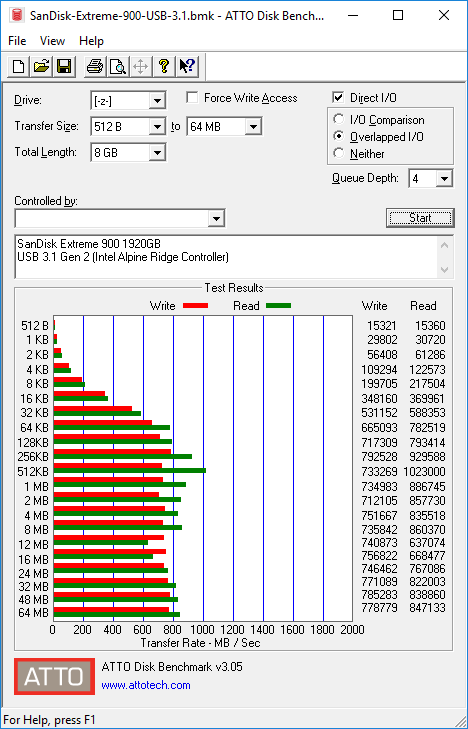
CrystalDiskMark, despite being a canned benchmark, provides a better estimate of the performance range with a selected set of numbers. As evident from the screenshot below, the performance can dip to as low as 26 MBps for random 4K accesses with low queue depths.
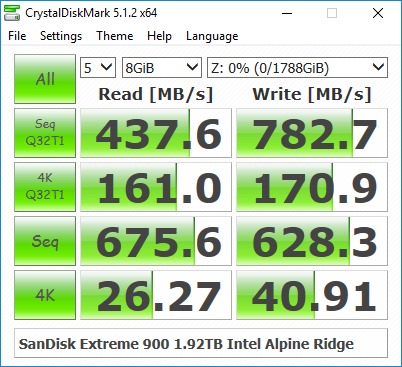
Benchmarks - robocopy and PCMark 8 Storage Bench
Our testing methodology for DAS units also takes into consideration the usual use-case for such devices. The most common usage scenario is transfer of large amounts of photos and videos to and from the unit. The minor usage scenario is importing files directly off the DAS into a multimedia editing program such as Adobe Photoshop.
In order to tackle the first use-case, we created three test folders with the following characteristics:
- Photos: 15.6 GB collection of 4320 photos (RAW as well as JPEGs) in 61 sub-folders
- Videos: 16.1 GB collection of 244 videos (MP4 as well as MOVs) in 6 sub-folders
- BR: 10.7 GB Blu-ray folder structure of the IDT Benchmark Blu-ray (the same that we use in our robocopy tests for NAS systems)





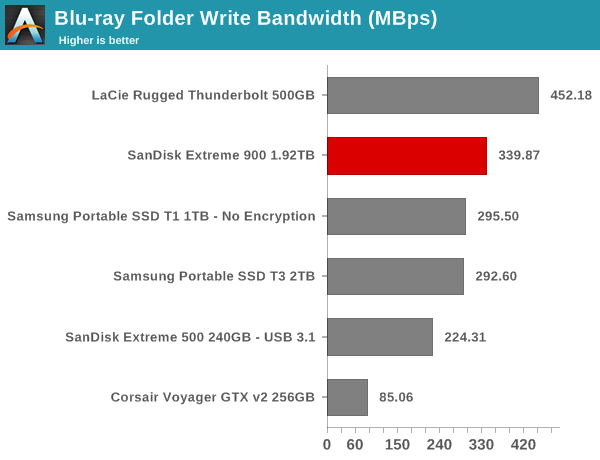
For the second use-case, we take advantage of PC Mark 8's storage bench. The storage workload involves games as well as multimedia editing applications. The command line version allows us to cherry-pick storage traces to run on a target drive. We chose the following traces.
- Adobe Photoshop (Light)
- Adobe Photoshop (Heavy)
- Adobe After Effects
- Adobe Illustrator
Usually, PC Mark 8 reports time to complete the trace, but the detailed log report has the read and write bandwidth figures which we present in our performance graphs. Note that the bandwidth number reported in the results don't involve idle time compression. Results might appear low, but that is part of the workload characteristic. Note that the same testbed is being used for all DAS units. Therefore, comparing the numbers for each trace should be possible across different DAS units.


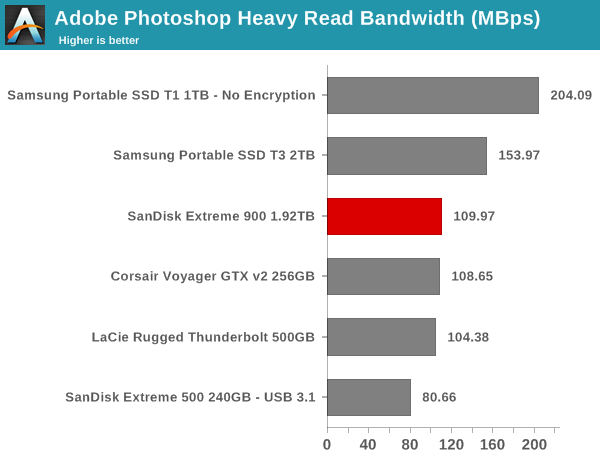

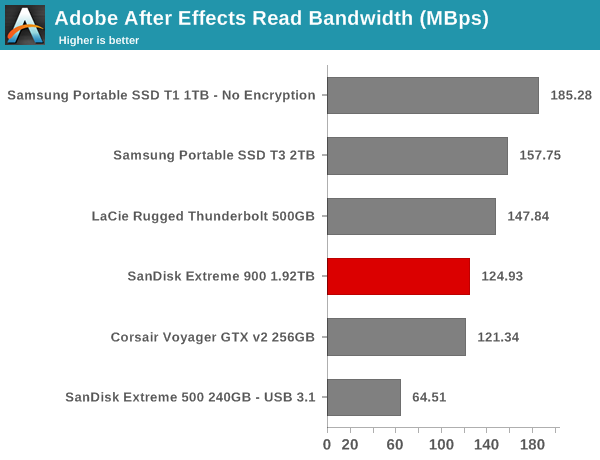
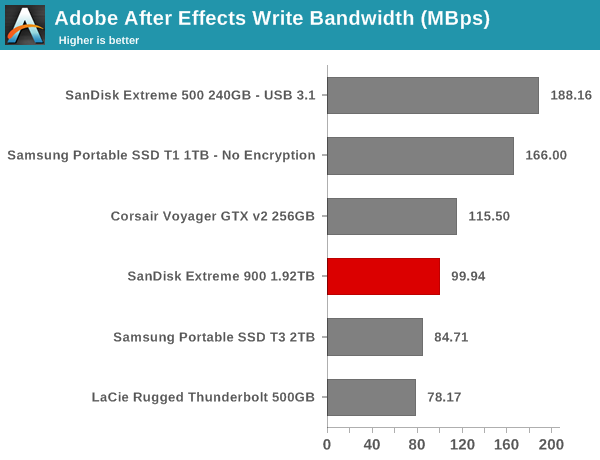
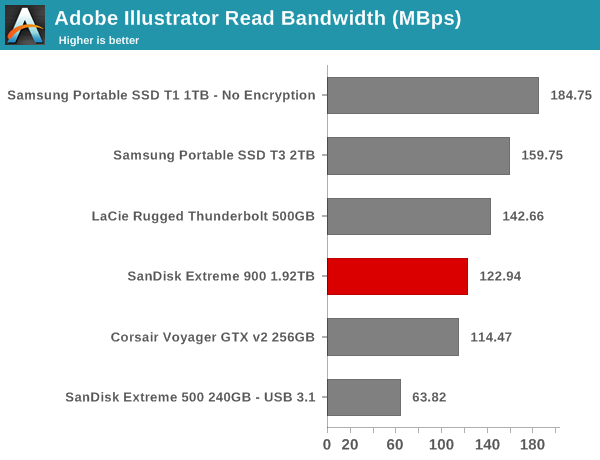

Certain access traces work heavily in favor of RAID 0 SSDs, but others end up with a run-of-the-mill performance. However, it can be said that the Extreme 900 works better than a USB 3.0 flash drive (SSD-based or otherwise) for most practical access traces.










31 Comments
View All Comments
MattMe - Tuesday, April 12, 2016 - link
The comment about being normal was written tongue firmly in cheek.pav1 - Tuesday, April 12, 2016 - link
Normal people don't post on forums.Ratman6161 - Monday, April 11, 2016 - link
Both SanDisk and Samsung have smaller capacity, lower priced versions of their drives that would be of interest. For example on Amazon SanDisk has a 960GB version for $500 which sounds like just 1 960 GB instead of two in RAID 0 (which may also solve the issue of no trim if its a single drive rather than RAID 0???). Samsung has: 250 GB T3 for $129, 500 for $197 and 1 TB for $427. The 500 GB actually seems pretty reasonable to me as its big enough to fit several VM's of the size I'd use it for and the price is still relatively low.ganeshts - Monday, April 11, 2016 - link
The 960GB version of the Extreme 900 is 2x 480GB in RAID-0jameskatt - Saturday, May 7, 2016 - link
The Mushkin Enhanced Reactor TC 2.5" 2 TB SATA III MLC Internal Solid State Drive (SSD) MKNSSDRE2TB-TC from Amazon costs $500. Place this in a thin $20 USB 3.0 enclosure. You'll save $300 over the SanDisk and Samsung external 2TB SSDs.zepi - Monday, April 11, 2016 - link
Sounds like a decent way of increasing the iops/storage when running a bunch of virtual machines on a laptop or even a desktop machine and taking them with you whereever you go.Not free for sure, but compared to the price of internal storage options and impossibility of even having 2TB in most laptops, this is not bad.
BrokenCrayons - Monday, April 11, 2016 - link
External storage for a virtual machines seems like a good use case for the Extreme 900. I can't think of too many others that would justify the fairly steep MSRP vs storage capacity that can readily benefit from the added performance.ImSpartacus - Monday, April 11, 2016 - link
It's sad that we have to say, "usb 3.1 gen2" now...Flunk - Monday, April 11, 2016 - link
USB 3.1 Gen 1 is such a scam.Gunbuster - Monday, April 11, 2016 - link
I would have thought $800 would afford you a enclosure design slightly more exciting than what can be had on amazon or eBay for $10